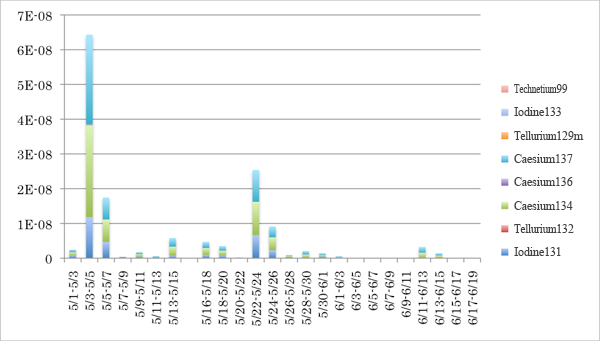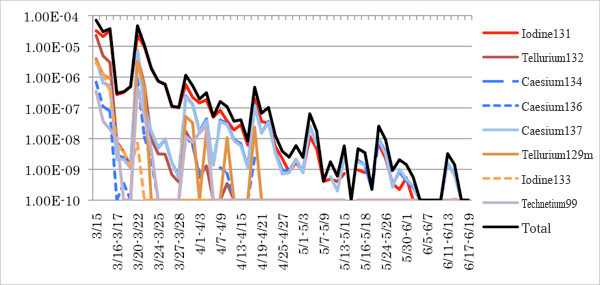KEK TOP >> English page >> Radiation monitoring >>
KEK | HIGH ENERGY ACCELERATOR RESEARCH ORGANIZATION
Jun 30, 17:00, 2011
Measurement result of airborne nuclide and air radiation level in Tsukuba area: tenth report
KEK, in conjunction with National Institute for Environmental Study (NIES) have been conducting the measurement to assess the airborne nuclide and air radiation level in Tsukuba area since 15 March. In this report, the results of measurements, conducted between 26 May and 19 Jun, are shown in the chart below. Please refer to the previous reports for the measurement results before 24 May.
KEK will have another measurement hereafter, and will report the result accordingly.
Measurement condition:
- Measurement point: In the premise of NIES (16-2 Onogawa, Tsukuba-City, Ibaraki)
- Air sampling instrument: High-volume air sampler, with the capability of filling 600 litters of air per minutes . Each measurement took two days for the sampling.
- Filter used: Collected by a quartz fiber filter and doubly stacked activated carbon filters
Filter analysis instrument: KEK's High Resolution Ge detector. In this report, counting time is extended to 20,000 to 40,000 seconds (it was 5,000 seconds in the previous reports).
Measurement result:
The measurement results are shown in Chart 1 to 3. The information on the weather conditions at the time of the measurements is posted on NIES's web site (http://www.nies.go.jp/shinsai/).
As the concentration of airborne nuclide decreases, we will issue the next report only if the concentration of radioactive nuclide exceeds the detection limit of our Ge detector.
Chart1 Results from 43th to 46th measurements: Detected nuclide and its concentration (Bq/cm3)
| 43th | 44th | 45th | 46th | |
| Measurement period | 5.26 10:49 - 5.28 10:49 | 5.28 11:56 - 5.30 10:26 | 5.30 10:32 - 6.1 10:32 | 6.1 10:49 - 6.3 10:26 |
| Air collected | 1,728m3 | 1,673m3 | 1,728m3 | 1,715m3 |
| Nuclide | CONC (Bq/cm3) | CONC (Bq/cm3) | CONC (Bq/cm3) | CONC (Bq/cm3) |
| I-131 | 3.4×10-10 | 2.2×10-10 | 5.3×10-10 | no detection |
| Te-132 | no detection | no detection | no detection | no detection |
| Cs-134 | 3.1×10-10 | 8.4×10-10 | 4.2×10-10 | 2.6×10-10 |
| Cs-136 | no detection | no detection | no detection | no detection |
| Cs-137 | 2.7×10-10 | 1.0×10-9 | 4.8×10-10 | 3.0×10-10 |
| Te-129m | no detection | no detection | no detection | no detection |
Chart2 Results from 47th to 50th measurements: Detected nuclide and its concentration (Bq/cm3)
| 47th | 48th | 49th | 50th | |
| Measurement period | 6.3 10:32 - 6.5 10:32 | 6.5 11:47 - 6.7 11:25 | 6.7 11:32 - 6.9 10:35 | 6.9 10:45 - 6.11 10:45 |
| Air collected | 1,728m3 | 1,714m3 | 1,694m3 | 1,728m3 |
| Nuclide | CONC (Bq/cm3) | CONC (Bq/cm3) | CONC (Bq/cm3) | CONC (Bq/cm3) |
| I-131 | no detection | no detection | no detection | no detection |
| Te-132 | no detection | no detection | no detection | no detection |
| Cs-134 | no detection | no detection | no detection | no detection |
| Cs-136 | no detection | no detection | no detection | no detection |
| Cs-137 | no detection | no detection | no detection | no detection |
| Te-129m | no detection | no detection | no detection | no detection |
Chart3 Results from 51th to 54th measurements: Detected nuclide and its concentration (Bq/cm3)
| 51th | 52th | 53th | 54th | |
| Measurement period | 6.11 11:06 - 6.13 10:35 | 6.13 10:41 - 6.15 10:33 | 6.15 10:40 - 6.17 10:22 | 6.17 10:29 - 6.19 10:29 |
| Air collected | 1,709m3 | 1,724m3 | 1,717m3 | 1,728m3 |
| Nuclide | CONC (Bq/cm3) | CONC (Bq/cm3) | CONC (Bq/cm3) | CONC (Bq/cm3) |
| I-131 | no detection | 1.0×10-10 | no detection | no detection |
| Te-132 | no detection | no detection | no detection | no detection |
| Cs-134 | 1.4×10-9 | 6.5×10-10 | no detection | no detection |
| Cs-136 | no detection | no detection | no detection | no detection |
| Cs-137 | 1.4×10-9 | 6.7×10-10 | no detection | no detection |
| Te-129m | no detection | no detection | no detection | no detection |

Fig. 1 : Concentration of the airborne nuclide since May (Bq/cm3)
Transition of concentration of the airborne nuclide since 1 May. (Bq/cm3) The level had been decreased since 20-22 May in the previous report, until Caesium was detected again on 11-15 June.

Fig. 2 : Variation of radioactivity originated by nuclear reactor accident in air since 15 March. (Bq/cm3)
Transition of concentration of the airborne nuclide in semi-log scale since 15 March. (Bq/cm3) Current concentration level is lower by 5 orders of magnitude compared to 15 March, and is not of health concern.
[ Contact ] KEK Public Relations Office TEL:029-879-6047
mailto:proffice@kek.jp
HIGH ENERGY ACCELERATOR RESEARCH ORGANIZATION, KEK
1-1 Oho, Tsukuba, Ibaraki 305-0801 Japan
Copyright (C) KEK. All Rights Reserved.